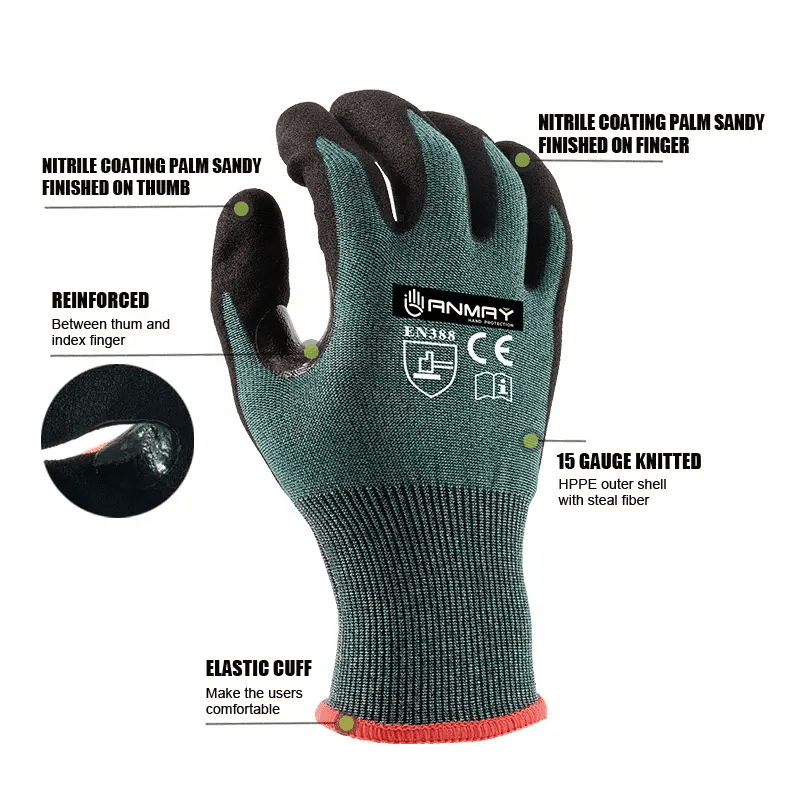
When it comes to hand protection, understanding cut resistance levels is essential. Without the right knowledge, choosing gloves could lead to safety risks. Let's explore this topic in depth.
Cut resistant gloves are categorized into different levels based on their ability to withstand cutting forces, ensuring adequate hand protection for specific hazards.
Choosing the wrong level can lead to accidents or overpaying for features you don’t need. Let’s break this down further to make it clearer.
What are the levels of cut resistant gloves?
The levels of cut resistant gloves are standardized to provide clarity in protection. Both ANSI and EN388 standards are widely used to categorize these levels.
Cut resistance levels range from low (A1 or Level 1) to high (A9 or Level 5) and are tested under specific conditions to ensure accuracy.
How are these levels defined?
The ANSI/ISEA 105 standard in the U.S. uses nine levels (A1-A9). Each level corresponds to a specific weight in grams required to cut through the glove material using a standardized blade. The EN388 standard used in Europe defines cut levels 1-5, measured using the Coup Test and TDM Test.
ANSI Cut Levels: A Quick Overview
| Level | Cutting Force (grams) | Typical Applications |
|---|---|---|
| A1 | 200-499 | Light tasks (office work) |
| A5 | 2200-2999 | Medium-high risks (glass) |
| A9 | ≥6000 | Extreme risks (metalwork) |
Understanding these levels helps you match the glove to the hazards of your work environment.
What is the difference between A5 and A7 cut resistant gloves?
When comparing A5 and A7 gloves, the main difference is their cutting force resistance. This determines their suitability for specific industries.
A5 gloves resist cutting forces of up to 2999 grams, while A7 gloves offer higher protection, withstanding forces between 4000-4999 grams.
Where would you need A5 vs. A7 gloves?
A5 gloves are often used in industries like construction or light manufacturing. They provide a balance of protection and flexibility, making them versatile. A7 gloves, on the other hand, are ideal for high-risk tasks, such as handling sharp glass or working with heavy-duty metal tools.
Comparing Applications of A5 and A7 Gloves
| Level | Best for Tasks Like |
|---|---|
| A5 | General construction, light metalwork |
| A7 | Industrial glass handling, machining |
Selecting between these two levels depends on the severity of the cutting hazards in your work.
Is cut level D the same as cut level 5?
Many confuse cut level D (EN388) with level 5. While they are related, they are not identical in testing methods and results.
Cut level D and level 5 represent high cut resistance, but level D is tested using the TDM method, making it more precise for industrial settings.
Understanding the Testing Methods
The Coup Test (used for Level 5) relies on a rotating blade to test cut resistance, but it can be inconsistent for certain materials like steel fibers. The TDM Test, used for Level D, applies a linear blade with precise force measurements, ensuring accuracy.
Differences Between Cut Level D and Level 5
| Feature | Level 5 (Coup Test) | Level D (TDM Test) |
|---|---|---|
| Testing Method | Rotating Blade | Linear Blade |
| Accuracy for Modern Fibers | Low | High |
| Typical Applications | Standard tasks | Complex industrial use |
For tasks requiring precision, level D gloves are often more reliable.
What are the different grades of gloves?
Cut-resistant gloves come in various grades, tailored for specific hazards and industries. These grades reflect materials, coatings, and overall durability.
Grades include basic, intermediate, and advanced gloves, with features like enhanced grip, puncture resistance, or chemical protection.
A Breakdown of Glove Grades
- Basic Grade: Ideal for minimal risks, these gloves often focus on comfort and light abrasion resistance.
- Intermediate Grade: Designed for moderate risks, they offer a balance of cut resistance and dexterity, often used in general industrial tasks.
- Advanced Grade: These gloves feature multi-layer protection, including anti-puncture and anti-vibration technologies, making them suitable for extreme environments.
Features to Consider Across Grades
| Feature | Basic | Intermediate | Advanced |
|---|---|---|---|
| Cut Resistance | A1-A3 | A4-A5 | A6-A9 |
| Grip Enhancement | Minimal | Moderate | Superior |
| Puncture Resistance | Low | Medium | High |
By matching the grade to your work environment, you ensure both safety and cost-effectiveness.
Conclusion
Understanding the levels and grades of cut resistant gloves is key to ensuring safety in hazardous work environments. Matching the glove to the task reduces risks and improves productivity.
